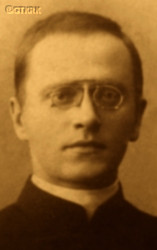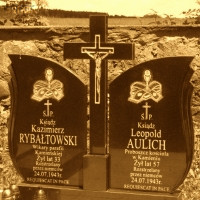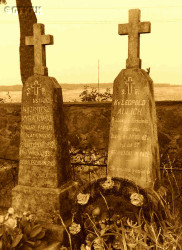Roman Catholic
St Sigismund parish
05-507 Słomczyn
85 Wiślana Str.
Konstancin deanery
Warsaw archdiocese, Poland
full list:
displayClick to display full list

searchClick to search full list by categories
wyświetlKliknij by wyświetlić pełną listę po polsku

szukajKliknij by przeszukać listę wg kategorii po polsku

Martyrology of the clergy — Poland
XX century (1914 – 1989)
personal data
surname
AULICH
forename(s)
Leopold
function
diocesan priest
creed
Latin (Roman Catholic) Church RCmore on
en.wikipedia.org
[access: 2014.09.21]
diocese / province
Pinsk diocesemore on
en.wikipedia.org
[access: 2013.05.19]
Minsk diocesemore on
en.wikipedia.org
[access: 2013.05.19]
Mogilev archdiocesemore on
en.wikipedia.org
[access: 2013.06.23]
RC Military Ordinariate of Polandmore on
en.wikipedia.org
[access: 2014.12.20]
date and place
of death
24.07.1943

Kamentoday: Ivyanets ssov., Valozhyn dist., Minsk reg., Belarus
more on
be.wikipedia.org
[access: 2023.01.18]
alt. dates and places
of death
26.07.1943, 08.1943
details of death
In 1917, after ordination, prob. became a cathedral vicar in Minsk, Belarus — then, in the summer of 1917, Poles constituted 23% of the city's population. At the same time, began postgraduate studies at the Sankt Petersburg Theological Academy, the only Catholic university in the Russian Empire awarding higher academic degrees. However, the overthrow of the tsarist regime in 02.1917 and the Bolshevik putsch in 11.1917 meant that the university de facto ceased to exist (it formally ceased to function in 04.1918). So remained in Minsk, which on 19.02.1918, was taken over, together with Belarusian units, by the 1st Polish Corps, formed alongside the Russian army, under the command of General Joseph Dowbor–Muśnicki, pushing the Bolsheviks out of the city. On 21.02.1918, however, the Germans, who had launched an offensive against the Bolsheviks in Belarus a few weeks earlier, entered Minsk and took over the government. The offensive ended on 03.03.1918, when the Central Powers participating in World War I, i.e. Germany and Austria–Hungary, signed a separatist peace treaty with Bolshevik Russia in Brest, leaving Minsk under German control. The 1st Polish Corps was disbanded.
Remained the cathedral vicar in Minsk till 1919, so it was there that likely experienced the German defeat and the end of World War I in 11.1918. The Bolsheviks took advantage of the situation and recaptured Minsk on c. 01.01.1919. The Polish–Russian War of 1919‐1921 was beginning, and on 08.08.1919, Minsk was occupied by the Polish Army under the command of General Stanislav Sheptytsky, in the course of a preemptive operation pushing the line of the northern Polish–Russian front as far east as possible, to the line of the Berezina River. Then was prob. transferred to Davyd‐Haradok, where prob. survived the Russian offensive of 1920, the Russian occupation from 07.1920 and the return of Davyd‐Haradok to independent Poland in 09.1920 — after the Polish triumph in the Battle of Warsaw on c. 15.08.1920, known as the „Miracle on the Vistula”.
In c. 1923 was an auxiliary chaplain of the Polish Army — based on the decision of 21‐22.08.1924, the 17th Border Battalion of the Border Protection Corps KOP „Dawidgródek”, was formed, stationed in Davyd‐Haradok.
After German invasion of Poland on 01.09.1939 (Russians invaded Poland 17 days later) and start of World War II, after German attack on 22.06.1941 of their erstwhile ally, Russians, and start of German occupation, denounced — prob. by Germ. Weißruthenische Hilfspolizei (Eng. Belarusian Auxiliary Police or Belarusian nationalists — and arrested by the Germans — accused of helping Jews, hiding in Naliboki Forest, and Polish partisans of Home Army AK (part of Polish Clandestine State).
Jews lived mainly in Iwieniec, c. 6 km away (in 1931 there were 1,563 of them out of 3,084 inhabitants, including 1,503 Poles). In the late autumn of 1941, the Germans closed the Jews in a ghetto, including the Jews from his parish Kamień. As early as c. 08.1942, the Germans — together with a Lithuanian detachment — Lit. Vokiečių Saugumo policijos ir SD ypatingasis būrys (Eng. Special Unit of the SD and Security Police), with the support of the Germ. Weißruthenische Hilfspolizei — in the nearby forests by the Volma River, murdered Jews. A small part of the younger ones escaped and hid in the nearby Naliboki Forest, where they joined the partisan unit „Otriad Belsky”, commanded by Tevye Belsky. This unit, together with a Russian partisan unit, also hiding in the Naliboki Forest, and consisting mainly of soldiers who in 1941, during the panic escape of the Russians, were not captured by the Germans, attacked Naliboki on 08.05.1943, murdering 128‐250 Poles.
Murdered during one of the massacres perpetrated by the Germans in retaliation for a partisan attack on Ivyanets, 6 km from his parish village (operation „Hermann”), together with his vicar, Fr Casimir Rybałtowski.
cause of death
mass murder
perpetrators
Germans
sites and events
Operation „Hermann”Click to display the description, Help to the JewsClick to display the description, Ribbentrop‐MolotovClick to display the description, Pius XI's encyclicalsClick to display the description
date and place
of birth
26.05.1886

alt. dates and places
of birth
Kievtoday: Kiev city rai., Kiev city obl., Ukraine
more on
en.wikipedia.org
[access: 2023.03.02]
parents
AULICH Arthur
🞲 ?, ? — 🕆 ?, ?

PODGÓRSKA Louise
🞲 ?, ? — 🕆 ?, ?
presbyter (holy orders)
ordination
30.04.1917

Sankt Petersburgtoday: Saint Petersburg city, Russia
more on
en.wikipedia.org
[access: 2020.07.31]
positions held
1935 – 1943
dean — Ivyanetstoday: Valozhyn dist., Minsk reg., Belarus
more on
en.wikipedia.org
[access: 2020.12.11] RC deanery
1935 – 1943
parish priest — Kamentoday: Ivyanets ssov., Valozhyn dist., Minsk reg., Belarus
more on
be.wikipedia.org
[access: 2023.01.18] ⋄ St Peter and St Paul the Apostles RC parish ⋄ Ivyanetstoday: Valozhyn dist., Minsk reg., Belarus
more on
en.wikipedia.org
[access: 2020.12.11] RC deanery
1930 – 1935
parish priest — Krivoshintoday: Krivoshin ssov., Lyakhavichy dist., Brest reg., Belarus
more on
be.wikipedia.org
[access: 2023.01.13] ⋄ St John the Baptist RC parish ⋄ Lyakhavichytoday: Lyakhavichy dist., Brest reg., Belarus
more on
en.wikipedia.org
[access: 2020.12.11] RC deanery — also: rector of fillial church in Lipsk
1927 – 1930
parish priest — Perlejewotoday: Perlejewo gm., Siemiatycze pov., Podlaskie voiv., Poland
more on
en.wikipedia.org
[access: 2022.01.06] ⋄ Transfiguration of the Lord RC parish ⋄ Ciechanowiectoday: Ciechanowiec gm., Wysokie Mazowieckie pov., Podlaskie voiv., Poland
more on
en.wikipedia.org
[access: 2022.01.06] RC deanery
c. 1923
RC auxiliary military chaplain — Polish Armed Forces
1919 – 1927
parish priest — Davyd‐Haradoktoday: Stolin dist., Brest reg., Belarus
more on
en.wikipedia.org
[access: 2020.12.11] ⋄ Corpus Christi RC parish ⋄ Luninetstoday: Luninets dist., Brest reg., Belarus
more on
en.wikipedia.org
[access: 2021.09.02] RC deanery — Initially administrator; also: acting („ad interim”) dean
1917 – 1919
vicar — Minsktoday: Minsk city reg., Belarus
more on
en.wikipedia.org
[access: 2020.07.31] ⋄ Name of the Blessed Virgin Mary RC cathedral church
1917 – 1918
student — Sankt Petersburgtoday: Saint Petersburg city, Russia
more on
en.wikipedia.org
[access: 2020.07.31] ⋄ philosophy and theology, Imperial Roman Catholic Spiritual Academy (1842‐1918) — postgraduate specialised studies, interrupted due to the Bolshevik putsch in Russia in 11.1917 and the closure of the university in 04.1918
1914 – 1917
student — Sankt Petersburgtoday: Saint Petersburg city, Russia
more on
en.wikipedia.org
[access: 2020.07.31] ⋄ philosophy and theology, Metropolitan Theological Seminary
others related
in death
RYBAŁTOWSKIClick to display biography Casimir
sites and events
descriptions
Operation „Hermann”: On 19.06.1943 a unit of Polish resistance Home Army AK (part of Polish Clandestine State) from Stowbtsy in Belarus attacked Ivyanets. The town was captured — in history this act is known as „Ivyanets insurgency” — and German garrison defeated. All prisoners were released, among them a dozen or so Jews, including a few physicians. C. 40‐150 Germans and their collaborators were executed. C. 100‐200 functionaries of Belarusian support police, collaborating with Germans, voluntarily joined the partisan unit. After 18 hours partisans left Ivyanets and moved towards nearby Nalibocka Forest. In retaliation Germans immediately murdered c. 150 inhabitants of Ivyanets and organized a wide ranging anti‐partisan operation known under its codename „Hermann”. The main aim was elimination of partisan units — Polish and Russian — operating in Nalibocka Forest. It started on 13.07.1943. C. 9,000 Germans and its collaborators — including Russians — participated supported by airplanes, artillery and heavy weaponry. Around the forest Germans set up a strip of „scorched earth”, c. 10‐15 km wide. During operation Germans burnt to ground more than 60 Polish and Belarus villages and murdered c. 4,280 civilians including a few Catholic priests — those regarded as supporting the partisans were executed, hanged, burnt alive. C. 21,000‐25,000 civilians were sent to 3rd Reich, i.e. Germany, for slave labour, and thousands — including elderly, women and children — were evicted beyond the blockade strip. Partisans however — both Polish and Russians — managed to break of the encirclement, despite huge losses. One of the towns in the vicinity of the region under operation — c. 20 km from Nalibocka Forest — was Nowogródek. During the operation Germans arrested there c. 120 its inhabitants and regarded as hostages. Local Sisters of the Holy Family of Nazareth nuns — in Nowogródek since 04.09.1929, providing religious education and instruction to children and youth — stood up in their defense. 11 of them were arrested by the Germans and murdered. (more on: en.wikipedia.orgClick to attempt to display webpage
[access: 2018.10.04])
Help to the Jews: During World War II on the Polish occupied territories Germans forbid to give any support to the Jews under penalty of death. Hundreds of Polish priests and religious helped the Jews despite this official sanction. Many of them were caught and murdered.
Ribbentrop‐Molotov: Genocidal Russian‐German alliance pact between Russian leader Joseph Stalin and German leader Adolf Hitler signed on 23.08.1939 in Moscow by respective foreign ministers, Mr. Vyacheslav Molotov for Russia and Joachim von Ribbentrop for Germany. The pact sanctioned and was the direct cause of joint Russian and German invasion of Poland and the outbreak of the World War II in 09.1939. In a political sense, the pact was an attempt to restore the status quo ante before 1914, with one exception, namely the „commercial” exchange of the so‐called „Kingdom of Poland”, which in 1914 was part of the Russian Empire, fore Eastern Galicia (today's western Ukraine), in 1914 belonging to the Austro‐Hungarian Empire. Galicia, including Lviv, was to be taken over by the Russians, the „Kingdom of Poland” — under the name of the General Governorate — Germany. The resultant „war was one of the greatest calamities and dramas of humanity in history, for two atheistic and anti‐Christian ideologies — national and international socialism — rejected God and His fifth Decalogue commandment: Thou shall not kill!” (Abp Stanislav Gądecki, 01.09.2019). The decisions taken — backed up by the betrayal of the formal allies of Poland, France and Germany, which on 12.09.1939, at a joint conference in Abbeville, decided not to provide aid to attacked Poland and not to take military action against Germany (a clear breach of treaty obligations with Poland) — were on 28.09.1939 slightly altered and made more precise when a treaty on „German‐Russian boundaries and friendship” was agreed by the same murderous signatories. One of its findings was establishment of spheres of influence in Central and Eastern Europe and in consequence IV partition of Poland. In one of its secret annexes agreed, that: „the Signatories will not tolerate on its respective territories any Polish propaganda that affects the territory of the other Side. On their respective territories they will suppress all such propaganda and inform each other of the measures taken to accomplish it”. The agreements resulted in a series of meeting between two genocidal organization representing both sides — German Gestapo and Russian NKVD when coordination of efforts to exterminate Polish intelligentsia and Polish leading classes (in Germany called «Intelligenzaktion», in Russia took the form of Katyń massacres) where discussed. Resulted in deaths of hundreds of thousands of Polish intelligentsia, including thousands of priests presented here, and tens of millions of ordinary people,. The results of this Russian‐German pact lasted till 1989 and are still in evidence even today. (more on: en.wikipedia.orgClick to attempt to display webpage
[access: 2015.09.30])
Pius XI's encyclicals: Facing the creation of two totalitarian systems in Europe, which seemed to compete with each other, though there were more similarities than contradictions between them, Pope Pius XI issued in 03.1937 (within 5 days) two encyclicals. In the „Mit brennender Sorge” (Eng. „With Burning Concern”) published on 14.03.1938, condemned the national socialism prevailing in Germany. The Pope wrote: „Whoever, following the old Germanic‐pre‐Christian beliefs, puts various impersonal fate in the place of a personal God, denies the wisdom of God and Providence […], whoever exalts earthly values: race or nation, or state, or state system, representatives of state power or other fundamental values of human society, […] and makes them the highest standard of all values, including religious ones, and idolizes them, this one […] is far from true faith in God and from a worldview corresponding to such faith”. On 19.03.1937, published „Divini Redemptoris” (Eng. „Divine Redeemer”), in which criticized Russian communism, dialectical materialism and the class struggle theory. The Pope wrote: „Communism deprives man of freedom, and therefore the spiritual basis of all life norms. It deprives the human person of all his dignity and any moral support with which he could resist the onslaught of blind passions […] This is the new gospel that Bolshevik and godless communism preaches as a message of salvation and redemption of humanity”… Pius XI demanded that the established human law be subjected to the natural law of God , recommended the implementation of the ideal of a Christian state and society, and called on Catholics to resist. Two years later, National Socialist Germany and Communist Russia came together and started World War II. (more on: www.vatican.vaClick to attempt to display webpage
[access: 2023.05.28], www.vatican.vaClick to attempt to display webpage
[access: 2023.05.28])
sources
personal:
www.glaukopis.plClick to attempt to display webpage
[access: 2012.11.23], www.polacyizydzi.plClick to attempt to display webpage
[access: 2013.02.15], kraj.byClick to attempt to display webpage
[access: 2016.03.14]
bibliographical:
„Martyrology of the Polish Roman Catholic clergy under nazi occupation in 1939‐1945”, Victor Jacewicz, John Woś, vol. I‐V, Warsaw Theological Academy, 1977‐1981
„Pinsk Diocese in Poland Clergy and Church Register”, Pinsk diocese bishop, 1933‐1939, diocesan printing house
original images:
kraj.byClick to attempt to display webpage
[access: 2016.03.14], www.iwieniec.euClick to attempt to display webpage
[access: 2013.12.04]
LETTER to CUSTODIAN/ADMINISTRATOR
If you have an Email client on your communicator/computer — such as Mozilla Thunderbird, Windows Mail or Microsoft Outlook, described at WikipediaPatrz:
en.wikipedia.org, among others — try the link below, please:
LETTER to CUSTODIAN/ADMINISTRATORClick and try to call your own Email client
If however you do not run such a client or the above link is not active please send an email to the Custodian/Administrator using your account — in your customary email/correspondence engine — at the following address:

giving the following as the subject:
MARTYROLOGY: AULICH Leopold
To return to the biography press below:
 Click to return to biography
Click to return to biography










